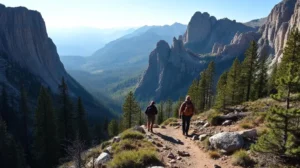
The United States is home to some of the most stunning and diverse landscapes in the north America, offering a wide range of hiking experiences for outdoor enthusiasts. From rugged mountains to lush forests, coastal cliffs to vast deserts, there’s a trail for every level of hiker. Here are some of the best hiking trails in the USA that will take your breath away and leave you yearning for more adventure.
7 Best Hiking Trails In The USA
1. Appalachian Trail (Georgia to Maine)
- Length: 2,190 miles
- Best Time to Hike: Spring through Fall
The Appalachian Trail, also known as the AT, is one of the most famous long-distance hiking trails in the world. Stretching from Springer Mountain in Georgia to Mount Katahdin in Maine, it spans 14 states and offers hikers a chance to experience the beauty of the Appalachian Mountains. While completing the entire trail is a monumental challenge (often taking five to seven months), many hikers choose to explore shorter sections. The trail is known for its rolling hills, diverse wildlife, and dense forests. Popular segments include the Smoky Mountains, Shenandoah National Park, and the White Mountains of New Hampshire.
2. Pacific Crest Trail (California to Washington)
- Length: 2,653 miles
- Best Time to Hike: April through September
Running from the Mexican border in California to the Canadian border in Washington, the Pacific Crest Trail (PCT) is a dream for avid hikers seeking a long-distance trek through the western United States. It takes hikers through a range of stunning environments, from the deserts of Southern California, the towering peaks of the Sierra Nevada, to the lush forests of the Pacific Northwest. The PCT gained widespread popularity after the release of Cheryl Strayed’s memoir Wild. While thru-hiking the entire trail is a major commitment, shorter sections can be enjoyed as day hikes or multi-day trips, such as the John Muir Trail in California.
3. Angels Landing (Zion National Park, Utah)
- Length: 5.4 miles (round trip)
- Best Time to Hike: Spring and Fall
Angels Landing in Zion National Park is one of the most thrilling and popular hikes in the USA. This 5.4-mile trail features steep switchbacks and narrow paths along sheer cliffs, culminating in breathtaking views of Zion Canyon. The final half-mile involves using chains bolted into the rock to navigate a narrow ridge with steep drop-offs on either side, making it a heart-pounding adventure. While the hike can be challenging and is not recommended for those afraid of heights, the view from the top is worth the effort. Due to its popularity, permits are required for hiking Angels Landing.
4. Half Dome (Yosemite National Park, California)
- Length: 14-16 miles (round trip)
- Best Time to Hike: May through October
Half Dome is an iconic granite peak in Yosemite National Park, and the hike to its summit is a bucket-list challenge for many adventurers. The trail is strenuous and requires a permit for the final ascent up the cables, which involves climbing the steep granite face of Half Dome using metal cables for support. The hike offers stunning views of Yosemite Valley, Vernal and Nevada Falls, and the surrounding granite cliffs. It’s a demanding day hike, but the sense of accomplishment and the panoramic views from the summit make it a rewarding experience.
5. Grand Canyon Rim-to-Rim (Arizona)
- Length: 24 miles (one way)
- Best Time to Hike: Spring and Fall
For those looking for an unforgettable challenge, the Rim-to-Rim hike in the Grand Canyon takes you from the North Rim to the South Rim, offering breathtaking views of one of the world’s most iconic natural wonders. The trail descends into the canyon, crossing the Colorado River before ascending back to the opposite rim. It’s a demanding hike due to the steep elevation changes and the desert heat, so proper preparation is essential. Many hikers choose to split the hike over two days, camping overnight at Phantom Ranch or Bright Angel Campground.
6. The Narrows (Zion National Park, Utah)
- Length: 16 miles (top-down); shorter options available
- Best Time to Hike: Summer and Fall
The Narrows is a unique hiking experience in Zion National Park that takes you through the narrowest section of Zion Canyon. Hiking through the Virgin River, with towering walls rising thousands of feet above, gives the feeling of walking through a slot canyon. While the full 16-mile top-down hike requires a permit and is typically done over two days, many visitors opt for the easier bottom-up day hike, which does not require a permit. The Narrows is best hiked in late summer and early fall when water levels are lower.
7. Kalalau Trail (Kauai, Hawaii)
- Length: 22 miles (round trip)
- Best Time to Hike: May through September
The Kalalau Trail on the island of Kauai is often considered one of the most beautiful and remote hikes in the world. This 22-mile round-trip trail takes hikers along the rugged Napali Coast, offering stunning views of lush valleys, dramatic cliffs, and the Pacific Ocean. The trail is strenuous and includes steep inclines and narrow paths along exposed cliffs, but the breathtaking scenery makes it worth the effort. The Kalalau Trail is best hiked during the dry season, as heavy rain can make the trail dangerous.
Tips For Hiking In the USA:
Research and Plan Thoroughly
- Investigate the specific trail, region, and seasonal conditions before your hike
- Check park websites, ranger stations, and local hiking forums for current trail information
- Download or obtain detailed topographic maps of the area
- Understand the difficulty level and terrain of your chosen trail
Essential Gear Preparation
- Invest in high-quality, comfortable hiking boots with good ankle support
- Pack layers of clothing to adapt to changing weather conditions
- Carry a lightweight, waterproof jacket and quick-drying clothing
- Bring a well-stocked first aid kit with personal medications
- Carry multiple water containers or a reliable water filtration system
- Pack high-energy, lightweight snacks like trail mix, energy bars, and dried fruits
Safety Precautions
- Always inform someone about your hiking route and expected return time
- Carry a charged mobile phone and portable battery pack
- Bring emergency communication devices like a satellite messenger in remote areas
- Pack a basic emergency survival kit with fire starter, emergency shelter, and signaling device
- Learn basic wilderness first aid and navigation skills
- Check weather forecasts and be prepared for sudden changes
Regional Considerations
- Different US regions require unique hiking preparations:
- Southwest: Carry extra water, protect against extreme heat
- Pacific Northwest: Prepare for rain and muddy conditions
- Rocky Mountains: Be ready for rapid elevation changes and potential altitude sickness
- Alaska: Carry bear spray and understand wildlife interaction protocols
Physical Preparation
- Build cardiovascular endurance through regular exercise
- Practice hiking with a loaded backpack before challenging trails
- Gradually increase hiking difficulty and trail complexity
- Understand your personal fitness limitations
Environmental Responsibility
- Follow Leave No Trace principles
- Pack out all trash and waste
- Stay on designated trails
- Respect wildlife and maintain a safe distance
- Obtain necessary permits for national parks and wilderness areas
Navigation and Technology
- Carry a physical map and compass as backup
- Use hiking apps and GPS devices like GPS watches and handheld GPS
- Download trail maps before losing cellular signal
- Consider a personal locator beacon for remote hikes
Wildlife and Natural Hazards
- Research local wildlife and potential encounters
- Understand how to respond to different animal interactions
- Carry appropriate protection like bear spray in relevant regions
- Learn to identify and avoid poisonous plants
- Understand potential natural hazards like flash floods, rockslides, and extreme temperatures
Seasonal Hiking Considerations
- Summer: Protect against heat and sun exposure
- Winter: Carry appropriate cold-weather gear
- Spring/Fall: Be prepared for unpredictable weather transitions
- Check trail conditions and seasonal accessibility
Budget and Logistics
- Budget for park entrance fees, parking, and potential shuttle services
- Consider purchasing an annual national parks pass if planning multiple visits
- Research camping and accommodation options near hiking trails
- Factor in transportation costs and potential gear rentals
Bonus Tip: Join local hiking groups or guided tours to gain region-specific insights and enhance your hiking experience. These communities can provide invaluable local knowledge and support.
By following these comprehensive tips, hikers can ensure a safe, enjoyable, and memorable experience exploring the diverse and stunning landscapes of the United States.
Conclusion
Whether you’re looking for hiking trails in the USA for multi-day backpacking adventure or a thrilling day hike, the USA is full of amazing hiking trails that cater to all levels of experience. From the iconic Appalachian Trail to the dramatic landscapes of Zion National Park, these trails offer a chance to connect with nature and explore some of the country’s most stunning wilderness areas. Lace up your boots, pack your hiking gear, and get ready to experience the best hiking trails the USA has to offer.


